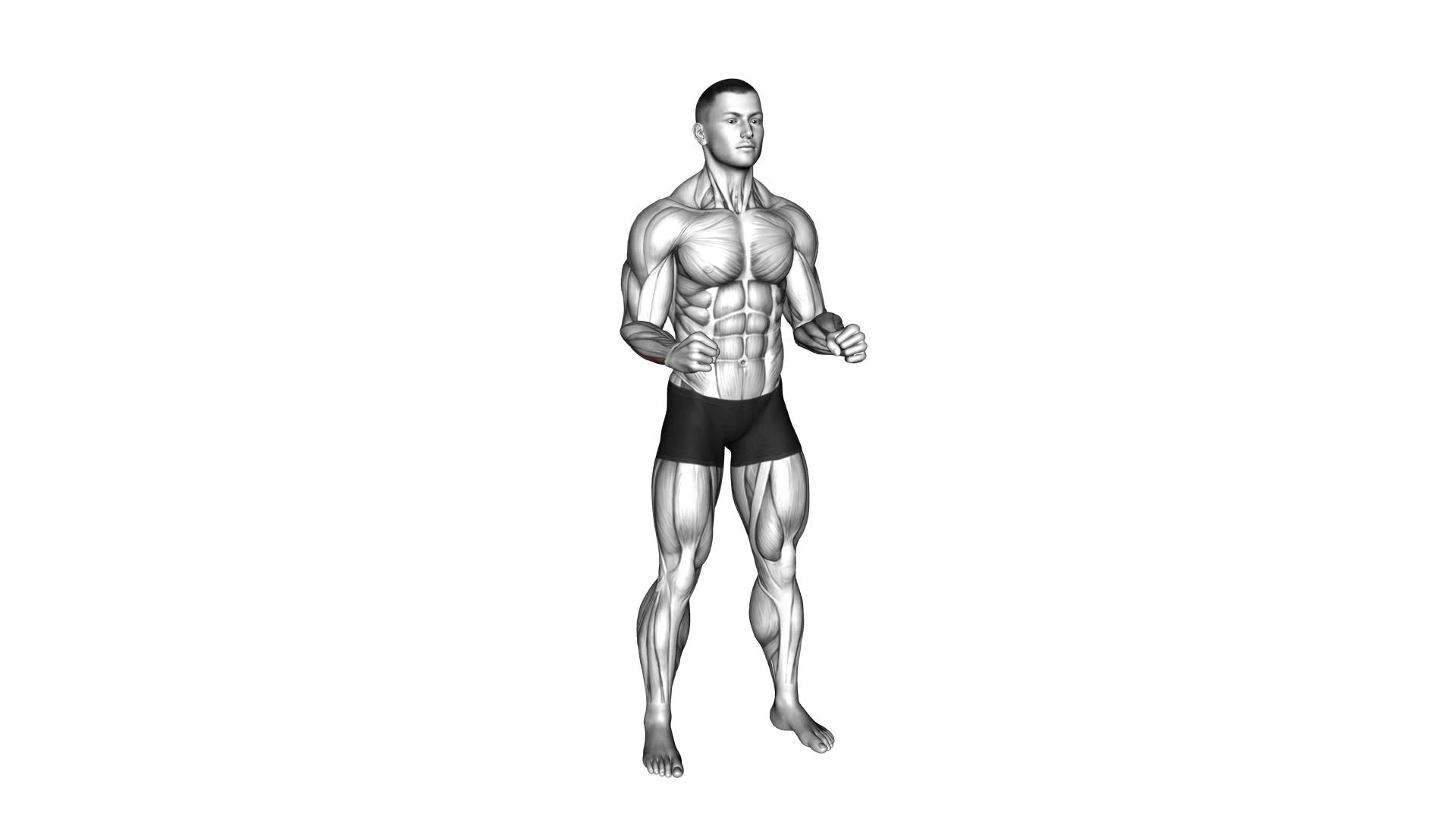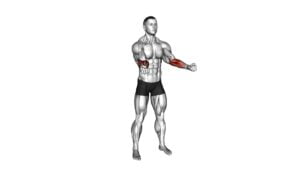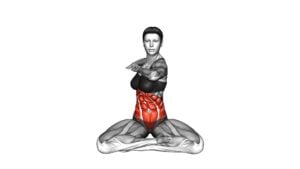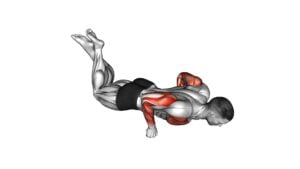Tight Fist Lift (male) – Video Exercise Guide & Tips

Get ready to strengthen your grip and build upper body strength with the Tight Fist Lift. This video exercise guide and tips will show you the proper form and technique, recommended weight and repetitions, variations and progressions, common mistakes to avoid, and tips for maximizing your results.
Watch This Exercise Video
Watch the video and follow along as you master this challenging exercise. Don't let your weak grip hold you back – start the Tight Fist Lift today!
Key Takeaways
- The Tight Fist Lift exercise helps increase grip strength and build forearm muscles.
- Proper form and technique, such as maintaining a neutral spine and engaging forearm muscles, are essential for maximizing the effectiveness of the exercise and minimizing the risk of injury.
- It is important to avoid common mistakes like using the shoulders or back instead of the hand and forearm muscles, and to maintain a tight grip on the weight while keeping the wrists in a neutral position.
- Incorporating variations of the exercise, such as changing the grip or adding instability, can help challenge different muscles in the forearms and wrists and prevent plateaus in strength and muscle growth.
Benefits of the Tight Fist Lift
You can experience increased grip strength and improved forearm muscles by performing the Tight Fist Lift exercise. This exercise is highly beneficial for individuals who engage in activities that require a strong grip, such as weightlifting, rock climbing, or playing certain sports.
One of the main benefits of the Tight Fist Lift is that it targets and strengthens the muscles in your forearms. By gripping a weight and lifting it using only your fingers and wrists, you're specifically working the muscles responsible for wrist flexion and extension. This not only improves your grip strength but also enhances your overall forearm strength and stability.
Additionally, the Tight Fist Lift can help prevent injuries related to weak grip strength. Having a strong grip is essential for maintaining proper form and technique in various exercises, such as deadlifts or pull-ups. By regularly incorporating the Tight Fist Lift into your workout routine, you can reduce the risk of dropping weights or losing control during these exercises.
To ensure you're performing the Tight Fist Lift with proper form, start by selecting an appropriate weight. Hold the weight in your hand, squeeze your fingers tightly around it, and then slowly lift it up towards your chest, using only your fingers and wrists. Remember to keep your forearm and upper arm stationary throughout the movement. Perform this exercise for a recommended number of repetitions and gradually increase the weight as your grip strength improves.
Proper Form and Technique
To perform the tight fist lift with proper form and technique, there are a few essential tips you should keep in mind.
First, make sure to maintain a neutral spine throughout the exercise to prevent any strain on your back.
Secondly, avoid using momentum or swinging your arms to lift the weight, and instead focus on engaging your forearm muscles.
Lastly, for the best results, exhale as you lift the weight and inhale as you lower it, maintaining control and stability throughout the movement.
Essential Form Tips
Achieving proper form and technique is crucial for optimal performance and results when performing the Tight Fist Lift exercise. To ensure you're getting the most out of this exercise and preventing injury, keep these essential form tips in mind:
- Maintain a neutral spine: Avoid rounding or arching your back during the exercise. Keep your spine in a neutral position to protect your lower back.
- Engage your core: Activate your core muscles throughout the movement to stabilize your body and protect your spine.
- Control your breathing: Breathe in during the lowering phase and exhale as you lift the weight. This will help you maintain control and stability.
By following these form tips, you can maximize the effectiveness of the Tight Fist Lift exercise and minimize the risk of injury.
Remember to always listen to your body and start with lighter weights if you're new to this exercise.
Avoiding Common Mistakes
Maintain proper form and technique to avoid common mistakes when performing the Tight Fist Lift exercise. By focusing on these aspects, you can improve your grip strength while preventing wrist injuries.
To begin, ensure that you have a tight grip on the dumbbell or weight plate throughout the exercise. This will engage the muscles in your hands and forearms, effectively working on your grip strength.
Additionally, keep your wrists in a neutral position, avoiding any excessive bending or twisting. This will help prevent strain or injury to your wrists.
Remember to lift the weight using the muscles in your hands and forearms, rather than relying on your shoulders or back.
Technique for Best Results
To maximize the benefits of the Tight Fist Lift exercise and achieve proper form and technique, you should focus on maintaining a tight grip on the dumbbell or weight plate throughout the entire movement. This will engage your forearm muscles and increase the effectiveness of the exercise.
Here are some tips to ensure you perform the Tight Fist Lift with the best technique:
- Keep your wrist straight and aligned with your forearm.
- Avoid using momentum or swinging the weight to lift it.
- Control the movement both on the way up and on the way down.
By following these guidelines, you'll target your forearm muscles effectively and minimize the risk of injury.
Now that you know the proper technique, let's move on to discussing the recommended weight and repetitions for the Tight Fist Lift exercise.
Recommended Weight and Repetitions
To determine the recommended weight and repetitions for the Tight Fist Lift exercise, you should consult with a qualified fitness trainer. They'll be able to assess your current fitness level and goals to provide personalized recommendations. The recommended weight for the Tight Fist Lift will vary depending on your strength and experience. It's important to start with a weight that challenges you but still allows you to maintain proper form throughout the exercise.
In terms of repetitions, a good starting point for beginners is to perform 8-12 repetitions per set. This range helps to build both strength and endurance. As you become more advanced, you can increase the number of repetitions or the weight used to continue challenging your muscles.
The Tight Fist Lift primarily targets the forearm muscles, including the flexor muscles in the wrist and fingers. It also engages the biceps and upper back muscles to a lesser extent.
When performing the Tight Fist Lift, it's important to take rest periods between sets to allow your muscles to recover. Aim for 1-2 minutes of rest between sets to ensure optimal performance.
Proper breathing techniques are crucial during the Tight Fist Lift. Inhale as you lower the weight and exhale as you lift the weight, focusing on controlled breathing throughout the exercise.
Before starting the Tight Fist Lift, it's important to warm up your muscles with some dynamic stretches and exercises. This helps to increase blood flow and prepare your muscles for the upcoming workout. Similarly, after completing the exercise, cool down stretches should be performed to aid in muscle recovery and prevent injury.
To support your training, proper nutrition and hydration are essential. Make sure to consume a balanced diet that includes enough protein, carbohydrates, and healthy fats to fuel your workouts and aid in muscle growth and recovery. Additionally, staying hydrated before, during, and after your training sessions is important for optimal performance and overall health.
When performing the Tight Fist Lift, it's important to follow some safety precautions. Always use proper form and technique to prevent injury. If you have any pre-existing conditions or injuries, consult with a medical professional before attempting this exercise.
Equipment options for the Tight Fist Lift include dumbbells, barbells, or resistance bands. Choose the equipment that best suits your preferences and goals. Remember to start with lighter weights and gradually increase the resistance as your strength improves.
In terms of training frequency, it's recommended to incorporate the Tight Fist Lift exercise into your routine 2-3 times per week. This allows for adequate rest and recovery between sessions while still providing enough stimulus for muscle growth.
Variations and Progressions
Explore different ways to challenge and advance your Tight Fist Lift exercise. Here are some variations and progressions that you can incorporate into your routine:
- Increase the weight: Once you have mastered the exercise with a certain weight, try adding more resistance. This will help you build more strength and muscle definition in your arms and shoulders.
- Change the grip: Instead of using a traditional fist grip, try using a pronated or supinated grip. This will engage different muscles in your forearms and wrists, providing a unique challenge and targeting specific areas.
- Add instability: Use a stability ball or a balance board to perform the Tight Fist Lift. By introducing instability, you won't only work your arms and shoulders but also engage your core muscles to maintain balance and control.
By incorporating these variations and progressions into your Tight Fist Lift exercise, you can continue to challenge yourself and prevent plateaus in your fitness journey. Remember to start with proper form and gradually increase the difficulty as you become more comfortable and confident.
Enjoy the benefits of a stronger upper body and improved muscle tone.
Common Mistakes to Avoid
Once you have incorporated the variations and progressions mentioned earlier, it's important to be aware of common mistakes to avoid when performing the Tight Fist Lift exercise. By being mindful of these mistakes, you can ensure that you're performing the exercise correctly and maximizing its benefits.
One common mistake to avoid is using improper technique. It's important to maintain proper form throughout the exercise to target the correct muscles and reduce the risk of injury. Make sure to keep your back straight and your core engaged. Avoid rounding your shoulders or arching your back as this can put unnecessary strain on your spine.
Another mistake to avoid is lifting too heavy of a weight. While it's important to challenge yourself, using weights that are too heavy can compromise your form and increase the risk of injury. Start with a weight that allows you to perform the exercise with proper technique and gradually increase the resistance as you become stronger.
Lastly, rushing through the exercise is a common mistake to avoid. Take your time and focus on each repetition, ensuring that you're performing the exercise with control and precision. This won't only maximize the effectiveness of the exercise but also reduce the risk of injury.
Tips for Maximizing Results
To maximize your results with the Tight Fist Lift exercise, there are a few key points to keep in mind.
First, focus on using effective workout techniques such as proper form and gradually increasing resistance.
Secondly, pay attention to your nutrition, ensuring you're fueling your body with the right nutrients to support muscle growth and recovery.
Lastly, don't forget the importance of rest and recovery days to allow your muscles time to repair and grow stronger.
Effective Workout Techniques
To maximize your workout results, incorporate effective workout techniques. Here are three tips to help you get the most out of your workouts:
- Vary your workout intensity: Incorporating high-intensity intervals into your routine can help increase calorie burn and improve cardiovascular fitness. Alternating between periods of high-intensity exercise and lower-intensity recovery periods challenges your body and keeps your workouts interesting.
- Focus on proper form: Performing exercises with correct form not only maximizes results but also helps prevent injuries. Take the time to learn the correct technique for each exercise and make sure you maintain proper alignment throughout your workouts.
- Modify exercises when needed: Don't be afraid to make modifications to suit your fitness level or accommodate any physical limitations. If an exercise feels too challenging or causes discomfort, find alternative movements or adjust the intensity to ensure a safe and effective workout. Remember, listening to your body is key to achieving your fitness goals.
Nutrition for Better Results
For better results in your workouts, focus on your nutrition by incorporating these tips.
Healthy eating plays a crucial role in maximizing your fitness goals. Start by planning your meals in advance to ensure you have nutritious options readily available.
Include a balance of protein, carbohydrates, and healthy fats in each meal to fuel your workouts and aid in muscle recovery.
Prioritize whole, unprocessed foods such as lean meats, fruits, vegetables, whole grains, and legumes.
Stay hydrated by drinking plenty of water throughout the day. Avoid sugary drinks and opt for water, herbal tea, or infused water instead.
Recovery and Rest Days
Maximize your workout results by prioritizing recovery and rest days, which are essential for muscle growth and overall fitness progress. It's important to give your body time to heal and repair after intense exercise. Here are some recovery techniques and the importance of rest:
- Active Recovery: Engage in low-intensity activities like walking or stretching on rest days. This helps increase blood flow, reduce muscle soreness, and promote faster recovery.
- Sleep: Make sure to get enough quality sleep each night. Sleep is crucial for muscle repair, hormone regulation, and overall recovery.
- Nutrition: Proper nutrition plays a vital role in recovery. Fuel your body with a balanced diet, including protein to support muscle repair and carbohydrates for energy replenishment.
Frequently Asked Questions
How Long Should I Hold the Tight Fist Lift Position?
When doing the tight fist lift exercise, it's important to focus on the position and form.
To progress in this exercise, start by holding the position for about 10-15 seconds and gradually increase the duration as you get stronger.
Be careful not to rush or strain your muscles.
Common mistakes to avoid include gripping too tightly or lifting your shoulders.
Remember to engage your core and breathe throughout the exercise for best results.
Can the Tight Fist Lift Exercise Help Improve Grip Strength?
Yes, the tight fist lift exercise can definitely help improve your grip strength. By holding a tight fist position, you engage the muscles in your forearms, which are crucial for grip strength. This exercise targets those muscles and helps to strengthen them over time.
However, if you're looking for alternative grip exercises, you might also consider exercises like farmer's walks or using grip trainers. These exercises can provide additional variety and challenge for your grip training routine.
Is It Necessary to Warm up Before Performing the Tight Fist Lift?
Before performing the tight fist lift, it's important to warm up your muscles. Warming up helps increase blood flow, improves flexibility, and reduces the risk of injury.
You can warm up by doing light cardio exercises like jogging or jumping jacks. Alternatively, you can also do dynamic stretches that target the muscles used in the tight fist lift.
Can the Tight Fist Lift Exercise Be Modified for Individuals With Wrist Injuries?
Exercise modifications for the tight fist lift can be made to accommodate individuals with wrist injuries. To modify this exercise, you can use lighter weights or resistance bands to reduce strain on the wrists.
Another option is to perform the exercise with an open hand instead of a tight fist, which can alleviate pressure on the wrists.
Remember to consult with a healthcare professional or a qualified trainer for personalized modifications that best suit your specific wrist injury.
Are There Any Specific Breathing Techniques to Follow During the Tight Fist Lift Exercise?
During the tight fist lift exercise, it's important to focus on your breathing technique. By inhaling deeply through your nose, you can engage your core muscles and increase stability.
As you lift your fists, exhale forcefully through your mouth, exerting power and control. This controlled breathing not only helps you maintain proper form, but also enhances the overall benefits of the exercise for building strength in your upper body and improving your overall fitness.
Conclusion
In conclusion, the tight fist lift is a beneficial exercise that can help strengthen your upper body muscles.
By following proper form and technique, using the recommended weight and repetitions, and avoiding common mistakes, you can maximize your results.
Don't forget to vary your workouts and gradually progress to more challenging variations.
With these tips and dedication, you can achieve your fitness goals with the tight fist lift.

Author
Years ago, the spark of my life’s passion ignited in my mind the moment I stepped into the local gym for the first time. The inaugural bead of perspiration, the initial endeavor, the very first surge of endorphins, and a sense of pride that washed over me post-workout marked the beginning of my deep-seated interest in strength sports, fitness, and sports nutrition. This very curiosity blossomed rapidly into a profound fascination, propelling me to earn a Master’s degree in Physical Education from the Academy of Physical Education in Krakow, followed by a Sports Manager diploma from the Jagiellonian University. My journey of growth led me to gain more specialized qualifications, such as being a certified personal trainer with a focus on sports dietetics, a lifeguard, and an instructor for wellness and corrective gymnastics. Theoretical knowledge paired seamlessly with practical experience, reinforcing my belief that the transformation of individuals under my guidance was also a reflection of my personal growth. This belief holds true even today. Each day, I strive to push the boundaries and explore new realms. These realms gently elevate me to greater heights. The unique combination of passion for my field and the continuous quest for growth fuels my drive to break new ground.







